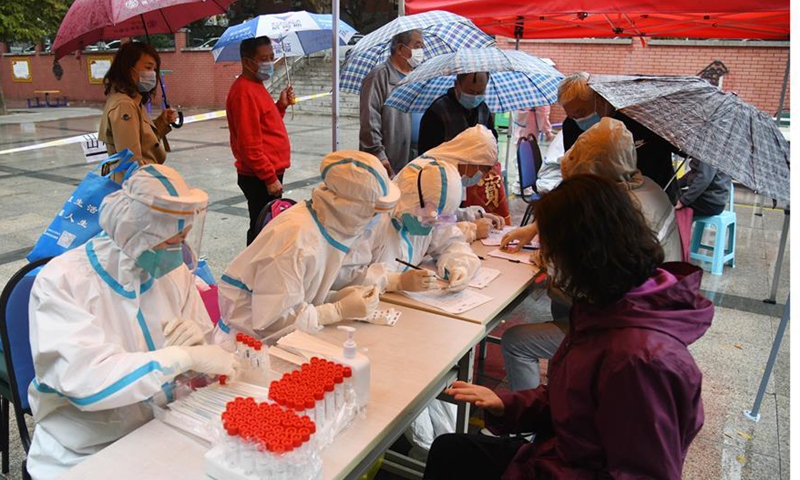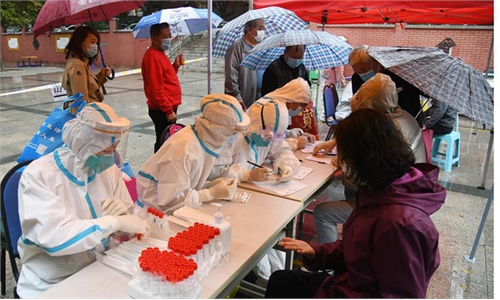Living coronavirus detected in imported frozen food packaging in Qingdao for 1st time, may push forward study of virus origins: virologist

People wait to take COVID-19 test at a square in Qingdao, east China's Shandong Province, Oct. 14, 2020. Over 8.8 million people had been sampled for nucleic acid testing by 6:00 p.m. Wednesday in east China's Qingdao City, after it began a city-wide testing campaign on Monday, according to local authorities. (Xinhua/Li Ziheng)
Chinese Center for Disease Control and Prevention (CDC) announced it has detected and isolated living coronavirus in a positive sample from the outer packaging of imported frozen cod, progress that virologists said could push forward research into the virus' origin, which may be aquatic creature.
The CDC made the discovery while tracing a new small-scale outbreak which occurred in Qingdao, East China's Shandong Province, saying that it shows exposure to virus-contaminated packaging can lead to infection, the CDC announced on its official website on Saturday.
It was the first time it has been confirmed that under special conditions of cold chain transportation outside the laboratory, the coronavirus can survive on packaging for a long time, signaling that the virus can be imported within the cold-chain food transportation process for long distances across borders, said the announcement.
Scientists had previously detected only viral nucleic acid from cold-chain packages. Living coronavirus is much more contagious than viral nucleic acid, and the discovery also proves that cold-chain provides suitable living conditions for the virus, Yang Zhanqiu, deputy director of the pathogen biology department at Wuhan University, told the Global Times on Sunday.
Yang said that this discovery shows that workers in the cold-chain industry, as well as wet market workers and employees in supermarket seafood sections, are at high risk.
The CDC also said that under such special conditions, the living virus could infect people who are not effectively protected, mainly workers in the cold chain sector. It suggested that while preventing imports of infected cases from abroad, China should also pay attention to the risk of importing the virus from cold-chain items, said the CDC.
The CDC noted that the infection risk to the public of being exposed to and eating cold-chain food is very low, as COVID-19 is not a food-borne illness and has not been found to cause infection through eating.
As of September 15, 24 provinces and regions in the country have reported 2.98 million test results, including 670,000 from cold-chain food and its packaging samples, 1.24 million samples from related workers and 1.07 million environment samples, with only 22 samples from food and its packaging testing positive, according to the announcement. The results showed that the nucleic acid load in the virus is low, said the CDC.
The Wuhan virologist also pointed out that successfully detecting living virus on cold-chain packaging helps push forward research into the virus' ability to survive, viral structure, and most importantly, its origins.
If the gene sequence of the living coronavirus contracted from the Qingdao cold-chain matches that in human beings, it may help bear out the possibility that the virus likely originates from aquatic creatures, not bats and pangolins, Yang said.
He said if the theory stands, it could also refute accusations which use the virus as a tool to throw mud at China. "If an aquatic creature proved to be the host, it may overturn many previous studies of the virus' origin," he said.
Many countries, including Spain, Italy and Japan have detected instances of the virus that may have existed before the outbreak in the Chinese city of Wuhan in January.
In July, researchers in Brazil said they detected the coronavirus that causes COVID-19 in sewage sampled in November.
The conclusion came days after scientists in Spain found the virus in waste water samples collected in March 2019, and adds to suggestions that the virus spread quietly before the alarm was first raised in China in late December.



